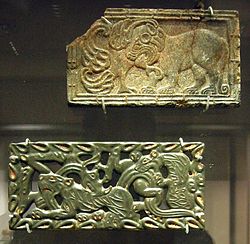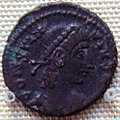Silk Road
The Silk Road was a group of trade routes across Asia that connected China with the Mediterranean region. It allowed Chinese traders to exchange things with Middle Eastern and Mediterranean traders.
The Silk Road was extremely important in world history. For the first time, people in different areas - and on different continents - could trade. The Silk Road was the first-ever connection between China, other parts of Asia, the Middle East, and Europe.
The silk trade
At the time, silk was only made in China, so it was extremely rare and expensive in Europe. For this reason, having silk was a sign of power, wealth, and importance for Europeans. Now, for the first time, it became much easier to get silk.
The silk trade brought a lot of wealth to China - and also to cities and markets along the Silk Road (like Samarkand and Bukharal in modern-day Uzbekistan). Trade on the Silk Road also helped ancient cultures grow in China, Egypt, Mesopotamia, Persia, India, and Rome.
A German geographer first called the route the Seidenstraße ("The Silk Road") in 1877.[1] He chose this name because traders used it to bring silk from west to east.[1]
Trade of other things
Of course, many other things were also traded, including:
- Porcelain and other types of pottery
- Foods[2]
- Wine[3]
- Spices
- Paper (from China)
- Metals and jewels
- Slaves (most likely)
- Ideas and knowledge
- Silk (Fabrics)
Traders also brought other things; for example, they brought chess pieces from northern India to China and Persia.
Most likely, no trader traveled the entire Silk Road alone. Instead, they traded goods at every stopping point along the Road. They sometimes made deals to get past difficult places.[4][5]
Path
Land routes
Over land, the Silk Road started in northern China and traveled west. Then it split into two branches. One went north of the Tibetan Plateau, and the other trail went south of it. Then the two trails rejoined.

After that, the Silk Road traveled in almost a straight line to the Mediterranean. It passed through mountain ranges in Tabriz (now in northern Iran) and the north tip of the Syrian Desert. From there, it traveled to the Levant (Syria, Israel, and Palestine).
From the Levant, land routes traveled north (through the Byzantime Empire) and south (to northern Africa).
Sea routes
The Silk Road also had water routes. These were also called the "Silk Road."
In Asia, the over-water Silk Road connected:
In Europe and the Middle East, it connected:
Past the Mediterranean Sea, the over-water routes continued to Portugal and Sweden. From there, goods were brought to places all over Europe.
Asian trades

From its beginnings (when Chinese people helped build it), the Silk Road was very important in Asia.
People along the route exchanged ideas as well as goods. These included ideas about religion, science, technology, culture, and philosophy.
The Buddhist religion and the Greco-Buddhist culture moved east on the Silk Road, reaching China around the second century BC. Trading also brought many arts, crafts, cultures, and foods to China.
The Kushan Empire in northwest India was in the middle of the Silk Road's trade routes. This helped the Empire become more powerful and wealthier. It also helped the rise of the Mongol Empire, the largest land empire ever.
The Roman Empire, which bought a lot of Chinese goods, began to fall from power in the West around the 5th century. In Central Asia, Islam expanded starting in the 7th century. Chinese growth westwards was ended at the Battle of Talas in 751 AD. Starting in the 10th century, trade also stopped from Central Asia because of the growth of the Islamic Turks.
Silk Road Media
Woven silk textile from Tomb No. 1 at Mawangdui, Changsha, Hunan province, China, dated to the Western Han Era, 2nd century BCE
Austronesian proto-historic and historic (Maritime Silk Road) maritime trade network in Southeast Asia and the Indian Ocean
Chinese jade and steatite plaques, in the Scythian-style animal art of the steppes. 4th–3rd century BCE. British Museum.
Soldier with a centaur in the Sampul tapestry, wool wall hanging, 3rd–2nd century BCE, Xinjiang Museum, Urumqi, Xinjiang, China.
A ceramic horse head and neck (broken from the body), from the Chinese Eastern Han dynasty (1st–2nd century CE)
Bronze coin of Constantius II (337–361), found in Karghalik, Xinjiang, China.
Indian art also found its way into Italy: in 1938 the Pompeii Lakshmi was found in the ruins of Pompeii (destroyed in an eruption of Mount Vesuvius in 79 CE).
Notes
- ↑ 1.0 1.1 Waugh, Daniel 2007. Richthofen's "Silk Roads": toward the archaeology of a concept. The Silk Road. 5, #1. [1] Archived 2012-09-15 at the Wayback Machine
- ↑ Some food, such as dates, figs and rice, can travel for long periods without being spoilt.
- ↑ Wine travelled in sealed jars. It does not go acid until air gets at it.
- ↑ Elisseeff, Vadime 2001. The Silk Roads: highways of culture and commerce. UNESCO Publishing / Berghahn Books. ISBN 978-92-3-103652-1
- ↑ Boulnois, Luce 2005. Silk Road: monks, warriors & merchants. Hong Kong: Odyssey Books. ISBN 962-217-721-2
Other websites
| Wikimedia Commons has media related to Lua error in Module:Commons_link at line 62: attempt to index field 'wikibase' (a nil value).. |
- The history of the Silk Road by Oliver Wild Archived 2016-03-15 at the Portuguese Web Archive
- Introduction of the Silk Road from a Turkish tour guide
- Old World Traditional Trade Routes Project
- Photos of Silk Road China Sights











